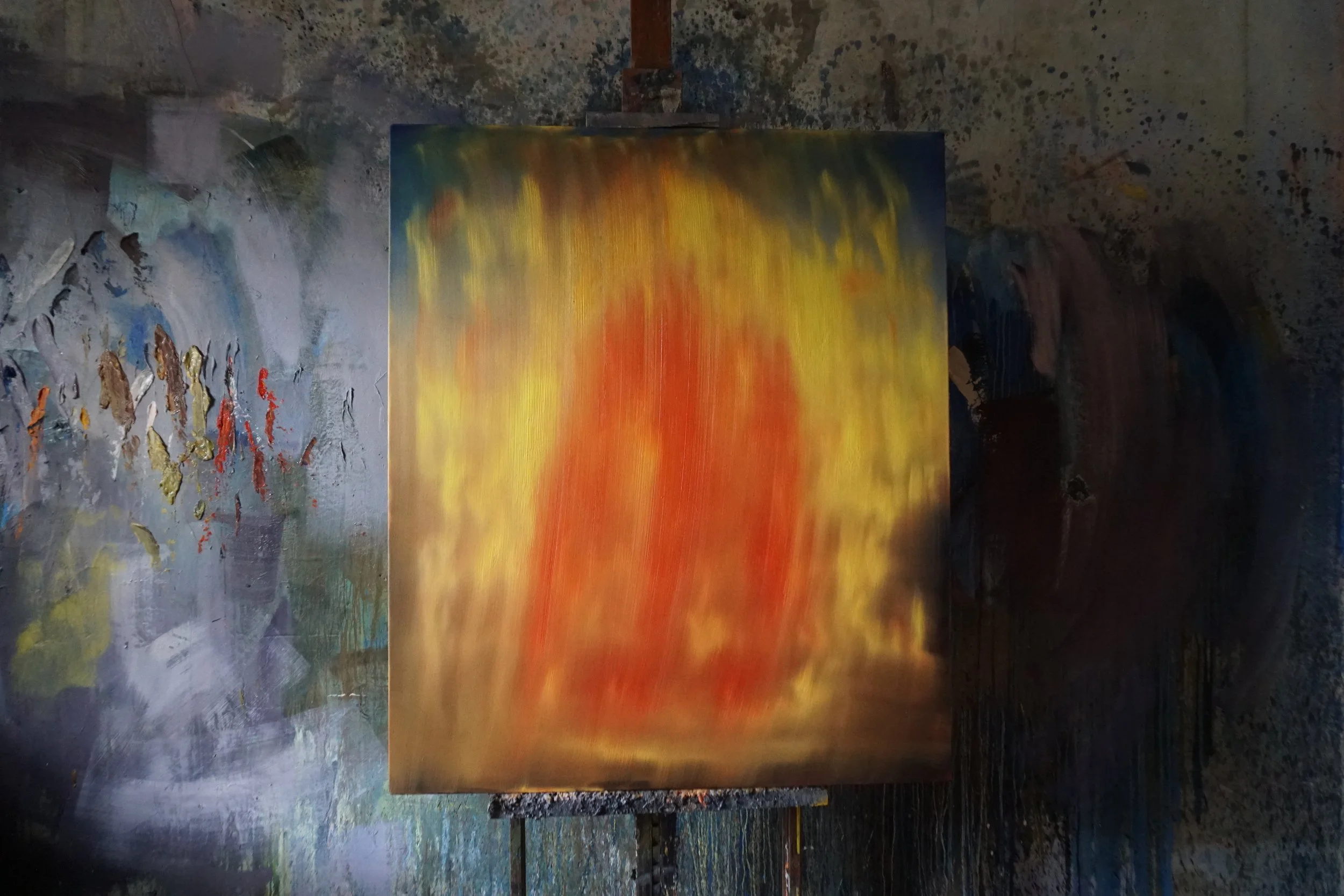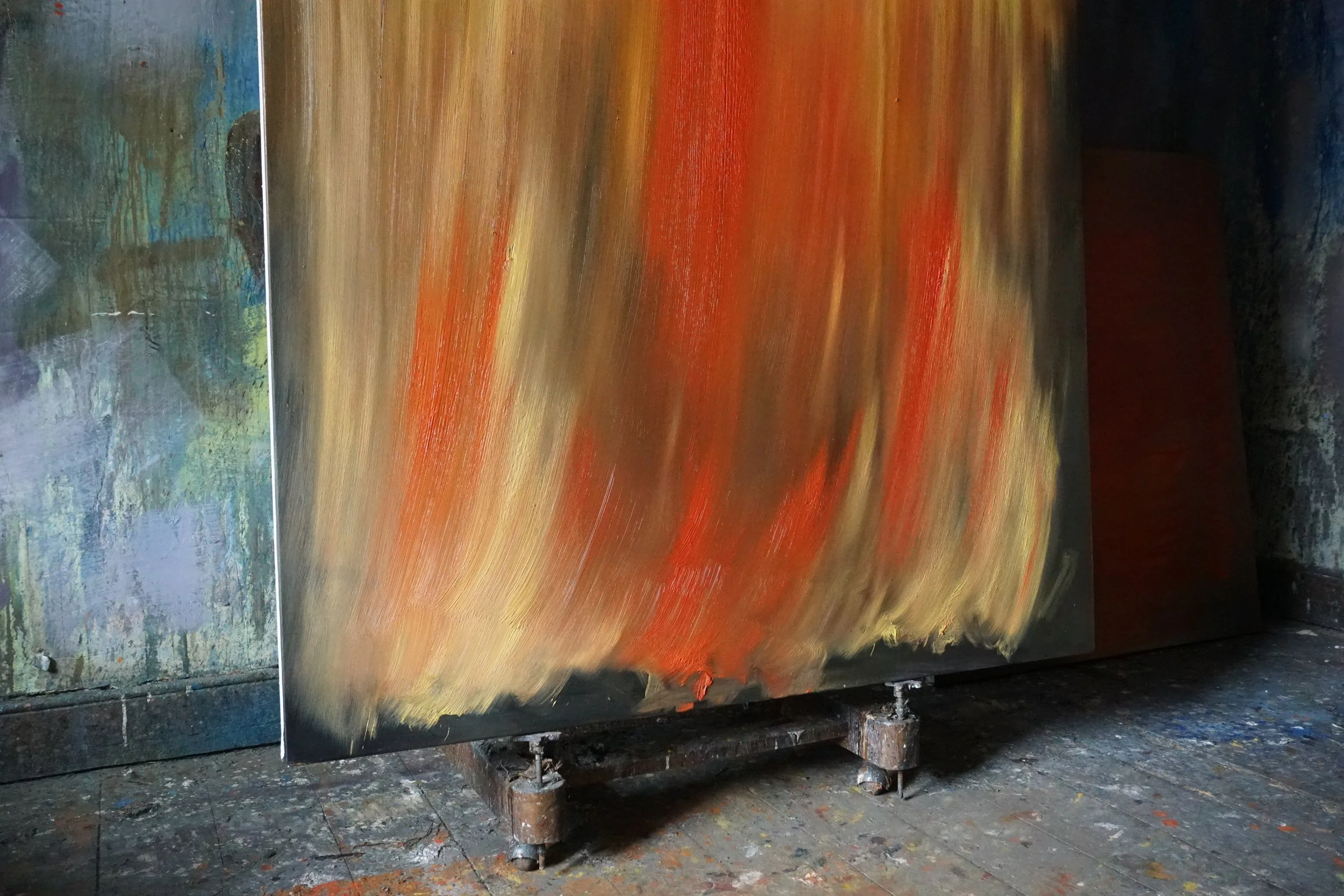It started with a sunset. More precisely a sky flooded with colour over a vast landscape dominated by the striking presence of Slemish mountain in Ireland. In this recent series of paintings William Foyle seeks to capture these fleeting effects of light and something of the essence of the Irish landscape that they illuminate. But he also brings both a poetic affinity and an oblique spirituality to his paintings. They are the physical translation of an intuitive response to a range of influences - from the poetry of Seamus Heaney to the lyrics of Scott Walker.
The landscape remains in the background of all the paintings, often only glimpsed at the edge of the canvas, the edge of our vision, but providing a constancy throughout this series. Slemish is always present on the horizon, just right of centre, though often obscured. The other constant is the use of text - a new focus in Foyle’s work - which is sometimes legible and sometimes barely visible at all, as he questions the relationship between text and image.
‘For she’d thought the shadow had left this land’, 2020, 124 x 105 cm, oil on canvas
There is a strong sense here of the awesome power of nature. The abstract quality of the paintings allows one to dwell on nature at both ends of the scale, from the endless depths of colour to be found within an ever-changing sky to the minute variations of green that ripple across the foliage of a lowly roadside plant. A mountain, in contrast, is immutable, reflecting the restless weather and the varying seasons, the protean nature surrounding it. These paintings might perhaps seek to achieve a similar role in capturing the transient and the eternal simultaneously.
The body of work is in three parts: a series of paintings inspired by the poetry of Seamus Heaney, another inspired by the lyrics of Scott Walker, and a third which takes the crucifixion as its theme.
'The Network of eternal life', 2020, 90 x 109 cm, Oil on canvas, from Seamus Heaney's 'St.Kevin and the Blackbird'
Seamus Heaney Paintings |
The first compositions use lines from the poem ‘Mint’ by Seamus Heaney. In ‘Almost Beneath Notice’ the text is clearly legible; the words seem to hover in a shimmering heat haze, rippling like flames, contained within a framing device that is similarly evanescent. In ‘The Light of Sunday Mornings’ the words are like shafts of light piercing the morning mist, almost visionary in effect. Meanwhile, ‘For He Had Forgotten Self' from Heaney’s ‘St. Kevin and the Blackbird’ sees these elements take on the likeness of deep purple rain clouds suffused with the rich hues of sunset, the darker, moodier colours recalling those used by Jack B. Yeats. The text pulsates with the power of nature - visually elevating the words to mean more than the simple metaphor - and at the same time the words lose their meaning, becoming pure form and colour, ephemeral as sparks of the imagination.
These paintings are composed in thinner paint - light veils of colour - and varnished, which helps to give them this ethereal luminosity. There is a central concentration of colour: the white light of the sun as you look directly into it; the red of glowing embers on the horizon - a colour that begins to develop into the centralised crucifix (‘My Last Things…’) - or in ‘The Network of Eternal Life’ (‘St. Kevin’) a dark centre that draws the eye into its depths. The dusty mint metamorphoses into a symbol of struggle, embracing the modern history of Ireland - in ‘We Failed them by our Disregard’ a weak light shines through red lettering threatened with erasure by the swirling brushstrokes. St. Kevin, meanwhile, embodies the compassion and selflessness of Christianity - ‘to labour and not to seek reward’ - as he holds the blackbird’s eggs in his hand, part of nature’s vast network of eternal life.
Scott Walker Paintings |
In the lyrics of Scott Walker in ‘Seventh Seal’, a knight returns home from crusade; the devastation he has wrought in the name of God has been revisited on him where he expects to find peace and heavenly reward. This echoes some of the themes in the poetry of Heaney, though in these paintings the fiery sunset is more readily interpreted as flames - rippling through ‘God Knows my Name’ - whether of conflict and destruction, or renewal.
'Their hands held as one solemnly danced towards the dawn’, 2020, 103 x 89 cm, oil on Canvas
Yellows and reds start to dominate in this series, concentrated into the form of a gothic arch. This shape, echoing the huge architectural presence of a cathedral, is abstracted here into a spiritual symbol, and used to frame the glowing text within. There is always a sense of movement, sometimes vertical, sometimes circular, sometimes pouring down from the apex of the arch. In ‘Their Hands Held as One Solemnly Danced Towards the Dawn’ the text seems on the point of being washed away, as though by the force of the yellow light sweeping downwards.
Detail of ‘A time will come when we know what all this is for’ , 2020, 180 x 124 cm, oil on canvas
'A Hidden Life' Paintings |
In these images, the culmination of Foyle’s investigation into text and light, the paint has become a much more physical substance. The impetuous, gestural brushstrokes leave clear evidence of the artistic process, and of a delight in the paint itself that echoes artists such as Leon Kossoff. There is less ‘working in’ of the paint, and more letting the paint speak for itself. Any text appears swept away by the energy of the paint, which pools at the top and bottom edges of the canvas in richly textured impasto.
There is a musicality to the layers of pigment that may have found inspiration in the choral works of John Tavener; ’The Protecting Veil’ seems visualised in the veils of paint through which the unmistakable symbol of the cross emerges. The figure of Christ becomes gradually clearer, like the substance of things cohering as dawn mists subside. Spirituality is explored much more openly - not only in the symbolism of the cross and the gothic arch, but also in the colours. Pure yellows, the cross always in red. The tonal gradations give way to an increasingly direct use of colour, the layers now coming through in streaks with a sense of revelation. There is always a margin of deep blue at the top edges like a heavenly firmament, a rich colour associated with the frescoes of early Renaissance masters such as Giotto.
‘For all eternity’, 2021, 203 x 123 cm, oil on canvas
The titles in this series derive from Terrence Malick’s film ‘A Hidden Life’, the true story of Franz Jagerstatter, an Austrian farmer who refuses to swear allegiance to the Third Reich and whose Christian faith sustains him through his imprisonment. There is a symbolism in the sunset which permeates all the paintings; it is a moment of reckoning, a test of faith, as the day turns to night - themes that suffuse Scott Walker’s ‘Seventh Seal’ as well.
Later paintings in this series introduce figures at the foot of the cross which alters the balance of the composition, the weight and dynamic between the parts, grounding the large canvases and also introducing movement from below. The final crucifixion reveals an image of Christ that is very human, as in Medieval or Northern Renaissance art, in pure red pigment. A crowd of figures below sway like flames, a mass of primitive humanity.
This figure of Christ on the cross is one that Foyle has studied repeatedly in both monotype prints and in watercolours, which have allowed a thorough investigation of form and colour that reaches its apogee in these large scale paintings.
Crucifixion, 2021, 160 x 140 , Oil on Canvas
For more information about featured works, sales enquiries or to arrange a studio visit, please contact us by email info@williamfoyle.com





